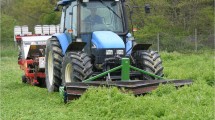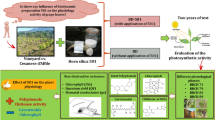Abstract
A four-year field experiment was conducted to compare conventional fertilization by broadcasting granular material with a combination broadcast/fertigation program. The experiment was conducted on mature ’Ruby Red’ grapefruit trees in a south Florida Flatwoods grove. The conventional fertilization (CONV) consisted of broadcast applications 3 times per year (Feb/Mar, May/Jun, Oct/Nov). The combination treatment (COMB) had a broadcast application of 33% of the annual N and K20 in Feb/Mar followed by the remainder applied as fertigation at 2-week intervals beginning in April. The CONV plots received 33% of the annual N and K20 (plus minor elements) during an application in late winter plus additional applications, each with a third of the annual N and K20 in the May/June and Oct/Nov time periods. During the four-year period, the COMB trees out-produced the CONV trees in 3 of the 4 years. The 4-year cumulative fresh fruit yield advantage of the COMB trees averaged 4150 kg ha−1 (108 boxes ha−1) per year advantage over the CONV program. The cumulative total soluble solids (TSS) produced over four years with the COMB trees averaged 10.9 Mg ha−1 versus 10.1 Mg ha−1 for the CONV treatment. The production increases by the COMB treatment over the CONV program represent 8% and 9% advantages for the TSS and fruit yield, respectively. The combination dry + fertigation treatment provided a higher fertilizer use efficiency (greater production for similar application rates) than the conventional dry broadcast applications alone.
Similar content being viewed by others
References
Calvert DV (1970) Response of ’Temple’ oranges to varying rates of nitrogen, potassium, and magnesium. Proc Fla State Hort Soc 83: 10–15
Calvert DV & Reitz HJ (1964) Effects of rate and frequency of fertilizer applications on yield and quality of Valencia oranges in the Indian River area. Proc Fla State Hort Soc 77: 36–41
Koo RCJ (1979) The influence of N, K, and irrigatian on tree size and fruit production of ’Valencia’ orange. Proc Fla State Hort Soc 92: 10–13
Koo RCJ, Anderson CA, Stewart I, Tucker DPH, Calvert DV & Wutscher HK (1984) Recommended fertilizers and nutritional sprays for citrus. Inst Food Agric Sci Univ Fla Bull 536D. 30 p
Miller I & Freund JE (1977) Probability and statistics for engineers. Prentice-Hall, Englewood Cliffs, NJ. 529 p
Reitz HJ & Long WT (1955) Water table fluctuations and depth of rooting of citrus trees in the Indian River area. Proc Fla State Hort Soc 68: 24–29
SAS Institute, Inc. (1985) SAS User's Guide: Statistics. Version 5 ed. SAS Institute Inc., Cary, North Carolina. 956 p
Smith PF, Scudder GK & Hrnciar G (1969) Nitrogen rate and time of application on the yield and quality of Marsh grapefruit. Proc Fla State Hort Soc 82: 20–25
Author information
Authors and Affiliations
Rights and permissions
About this article
Cite this article
Boman, B.J. Fertigation versus conventional fertilization of flatwoods grapefruit. Fertilizer Research 44, 123–128 (1995). https://doi.org/10.1007/BF00750801
Received:
Accepted:
Issue Date:
DOI: https://doi.org/10.1007/BF00750801




